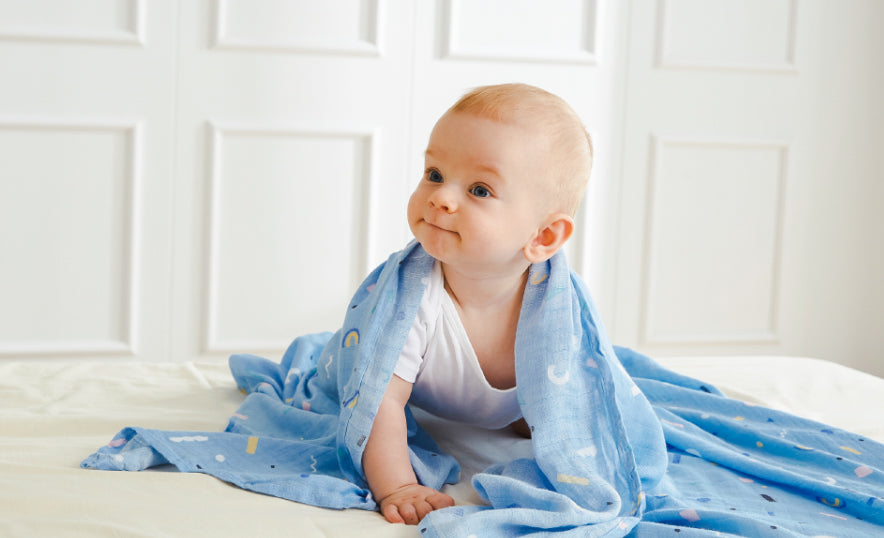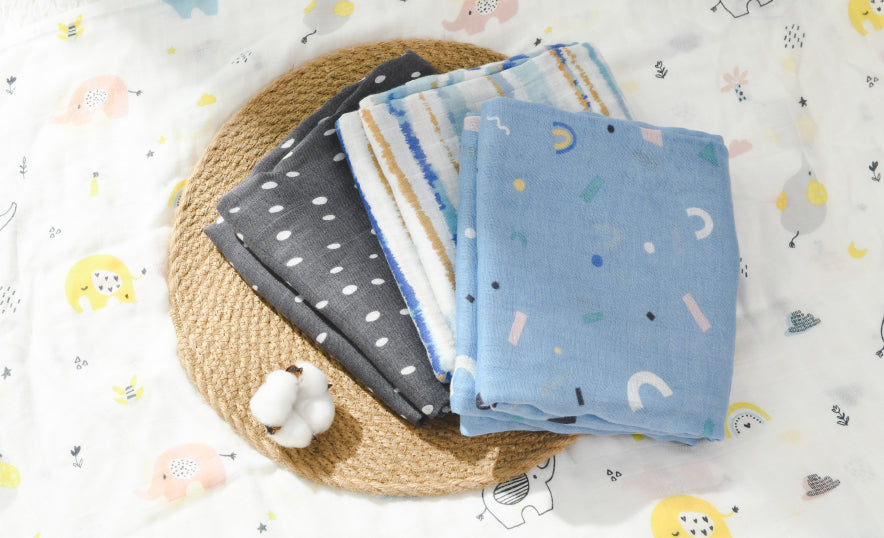| Characteristics | Muslin | Bamboo |
|---|---|---|
| Fabric | Lightweight cotton with loose weave | Silky soft bamboo viscose or rayon |
| Texture | Gauzy, breathable | Luxuriously smooth and soft |
| Breathability | Very high | Moderate |
| Comfort | Better for summer | Warmer for winter |
| Durability | Prone to tearing when washed rough | Holds up well to frequent washing |
| Eco-Friendliness | Organic muslin has lower footprint | Look for safe Oeko-Tex certification |
| Expert Recommendations | Ideal for breathability | Provides cozy, snuggly feel |
As a new mother, you are always prepared with all the things necessary for your child. One of these things is baby swaddles. This is what mothers typically use for their newborns to feel safe and secure when they enter the new world. But when it comes to swaddles, you will find different variations available for your baby, including muslin swaddles and bamboo swaddle blankets.
Swaddling is an age-old practice of wrapping infants snugly in blankets or cloth to provide comfort, security and promote better sleep. As a new parent, choosing the right swaddle material is important to ensure your baby's safety and comfort.
Muslin and bamboo are two of the most popular fabrics for modern swaddles. But with so many options available, how do you decide what's best for your little one?
This guide will compare muslin and bamboo swaddle blankets to help you make an informed decision. We'll dive into the key differences in:
- Fabric composition
- Texture and softness
- Breathability and comfort
- Durability and care
- Environmental impact
- Expert opinions and parental experiences

What is Muslin?
Muslin is a lightweight, breathable cotton fabric with a plain weave structure. The threads are only loosely spun together, giving it a gauzy, semi-sheer appearance.
True muslin is made from 100% organic cotton. Some modern muslins may contain a cotton-bamboo blend to enhance softness. The fibers used impact the texture - Egyptian or Pima cotton makes the silkiest muslins.
Muslin swaddle blankets have an airy, lightweight feel. The fabric gets softer over time and repeated washing.
What is Bamboo Fabric?
Bamboo fabric is made from bamboo pulp derived from the bamboo plant. Bamboo viscose or rayon has a silky soft texture, often described as luxurious.
Bamboo is naturally antimicrobial and hypoallergenic. However, most commercial bamboo textiles use chemical processes to break down the bamboo fibers. Opt for bamboo swaddles with Oeko-Tex certification for chemical safety.
Bamboo swaddles have a ultra-soft, smooth finish. The fabric retains its softness after repeated use and washes.
Texture and Softness
The main distinction between muslin and bamboo swaddles is in their texture and feel:
-
Muslin has a lightweight, gauzy texture. It starts out slightly crisp but softens over time. Muslin offers more breathability and air circulation.
-
Bamboo has a luxuriously soft, smooth and silky texture. It retains its softness even after repeated washing. Bamboo provides a cozier wrapped feel.
While muslin is soft, bamboo swaddles offer next-level softness that many parents rave about. The smooth finish and fluid drape makes bamboo swaddles extra snuggly.
Breathability and Comfort
Breathability is crucial for safe baby swaddling. Both muslin and bamboo offer good air circulation but muslin is more breathable:
-
The loose weave and lightweight nature of muslin allows maximum airflow. This makes it ideal for warmer months or climates.
-
Bamboo is more moisture-wicking than absorbent. It offers moderate breathability, making it suitable year-round. Its natural temperature regulating properties help baby stay comfy.
Muslin's higher breathability lends itself to comfort in summer while bamboo's warmth shines in winter. Combining them gives you the best of both worlds!

Durability and Care
Taking proper care of your swaddle blankets ensures they last through multiple babies.
-
Muslin gets softer over time but the lightweight fabric is prone to tearing if handled roughly. Wash gently and avoid high heat.
-
Bamboo is naturally more durable and resistant to shrinking or pilling. It can withstand frequent washing on warm or hot cycles.
While muslin requires a bit more delicate care, both fabrics are relatively easy to launder and maintain as long as you follow washing instructions.
Sustainability and Environmental Impact
Eco-conscious parents should consider the ethical and ecological footprint of textile production:
-
Muslin is biodegradable but conventional cotton farming has a large water footprint. Opt for organic muslins or eco-friendly dyes.
-
Bamboo viscose utilizes harsh chemical solvents during processing. Look for non-toxic bamboo textiles certified by Oeko-Tex.
Organic certification and safe manufacturing processes can make both muslin and bamboo more eco-friendly choices.
Swaddle blankets is important, click here to get more notices for making safe environment for babies.

Expert Opinions and Parent Feedback
When choosing the best fabric, real-life experiences provide valuable perspective.
Momcozy recommends lightweight muslin swaddles for optimal breathability. He advises against using thicker blankets or overheating babies.
Parent reviews highlight how ultra-soft bamboo makes swaddling easier and keeps babies happily nested. Those using both types praise the versatility of combining muslin and bamboo.
First-time mom Nisha says:
"I use muslin for swaddling during summer as it's nice and airy. When it gets cooler, I switch to bamboo for its warmth and buttery softness against her skin. Having both types keeps my baby comfortable year round."
The Takeaway
Here are the key differences between muslin vs bamboo swaddle blankets:
- Muslin is lightweight and breathable while bamboo is silkily soft but warmer.
- Muslin gets softer over time but is less durable while bamboo maintains its softness and is more resilient.
- Muslin requires gentler wash care while bamboo can withstand frequent washing.
- Muslin may be a more eco-friendly choice depending on production methods.
The ideal material depends on factors like climate, your baby's needs and personal preferences. Many parents find value in having both muslin and bamboo swaddles to combine the best qualities of each fabric.












